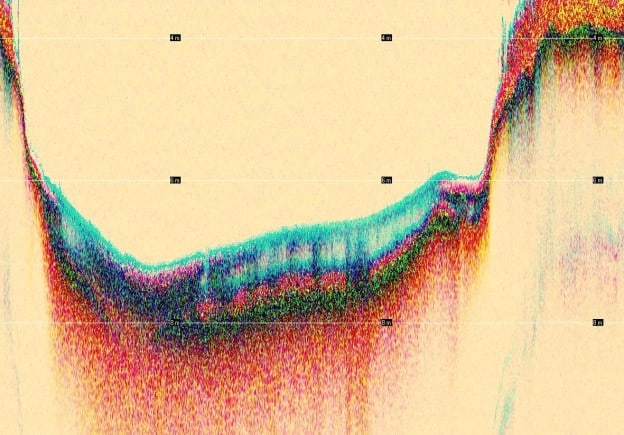
Sub-Bottom Discussion
Sub-Bottom Sediment Profiling in Reservoir Management
By Paul D. Higley, President Specialty Devices, Inc. 
The acoustic reflectivity of the bottom can vary widely depending on the composition of the bottom and water content. Rock, sand, clay, mud, and silts all have drastically different acoustic properties. Generally, sound will penetrate to greater depths with lower frequencies but better resolution can be achieved with higher frequencies. High water content silts can be acoustically transparent at a frequency of 3.5 kHz but 3.5kHz may be needed to reach bedrock through sand layers. A 200 kHz frequency transmission may be needed to detect the more transparent layers typical near the surface of the bottom. Additional frequencies may be needed to define fine layering between the rock and the sediment surface. While some sediments can be penetrated nearly 100 meters at 12 kHz, other sediments may not allow even 3.5 kHz sound to penetrate more than a few meters. Still other sediments may be so acoustically transparent that 12 kHz may miss the interface between the water and the surface of the bottom and thus report erroneously deep depths. The large transducer size needed to generate significant sound levels in shallow water at low frequencies adds a further complication to shallow water sediment surveying. Chirp technology attempts to spread sound over a wider frequency range from a single transducer. These are limited in frequency range to less than one octave due to the limited frequency range available from single transducer and therefore are limited in the ability to address the full range of sediment types. The many trade-offs have complicated small boat operations common in water reservoir surveying by requiring a wide array of bulky equipment that is unsuited for small boat operations. These factors all point to the need for a broad frequency capability with a wide dynamic range digitizer in a sediment profiler that is suited for operation in small boats.
The Specialty Devices, Inc. BSS+ system was designed to meet this need and can be equipped with up to five separate simultaneous transmission frequencies to provide the operator with the optimum capability for the conditions he may encounter. These frequencies are 3.5 kHz, 12 kHz, 24 kHz, 48 kHz and 200 kHz. All frequencies are digitized at 100 kHz rate using a 16 bit digitizer. The 200 kHz signal is rectified and integrated to resolve bottom reflection to bottom reflections to less than 1 inch resolution. In addition to the improvement in penetration and fine sediment layer definition, the multiple frequency data collected with the BSS+ can be processed with SDI’s color processing software to permit the operator to see and track fine gradations in sediment type. Small variations in sand, silt or clay content can be detected and tracked throughout a reservoir. A key to making this capability work is provided by the 16bit digitizer used to digitize all returning echoes. The old paper recording sub-bottom profilers provided 16 shades of gray to view sub-bottom information. This system digitizes 65,536 levels (or shades of gray) of the return signal on all frequencies. When the echoes for all frequencies are processed together both the large and the very small variations in reflectivity with frequency can be detected and displayed. This allows simple display of the wide variability of sediment characteristics and thus the classification of the sediment type in sub-bottom records.
The DEPTHPIC software allows the operator to change the weighting of each frequency to highlight different sediment characteristics. SDIDCON software takes advantage of the high digitization rate and broad dynamic range of the digitized data to perform deconvolution algorithms that further sharpen and enhance the post-processed sub-bottom layer data. Specialty Devices, Inc. has studied the problems involved with shallow water sub-bottom profiling and sediment classification surveying for many years. The result is the BSS+ system. It has been designed to provide the best possible capabilities for defining the sediments both in thickness and type, with a system that is still highly portable and does not require large equipment or power generators. The BSS+ system, while having a wide capability, is still a small, portable, self-contained, and waterproof system that operates from a 12 volt battery.
